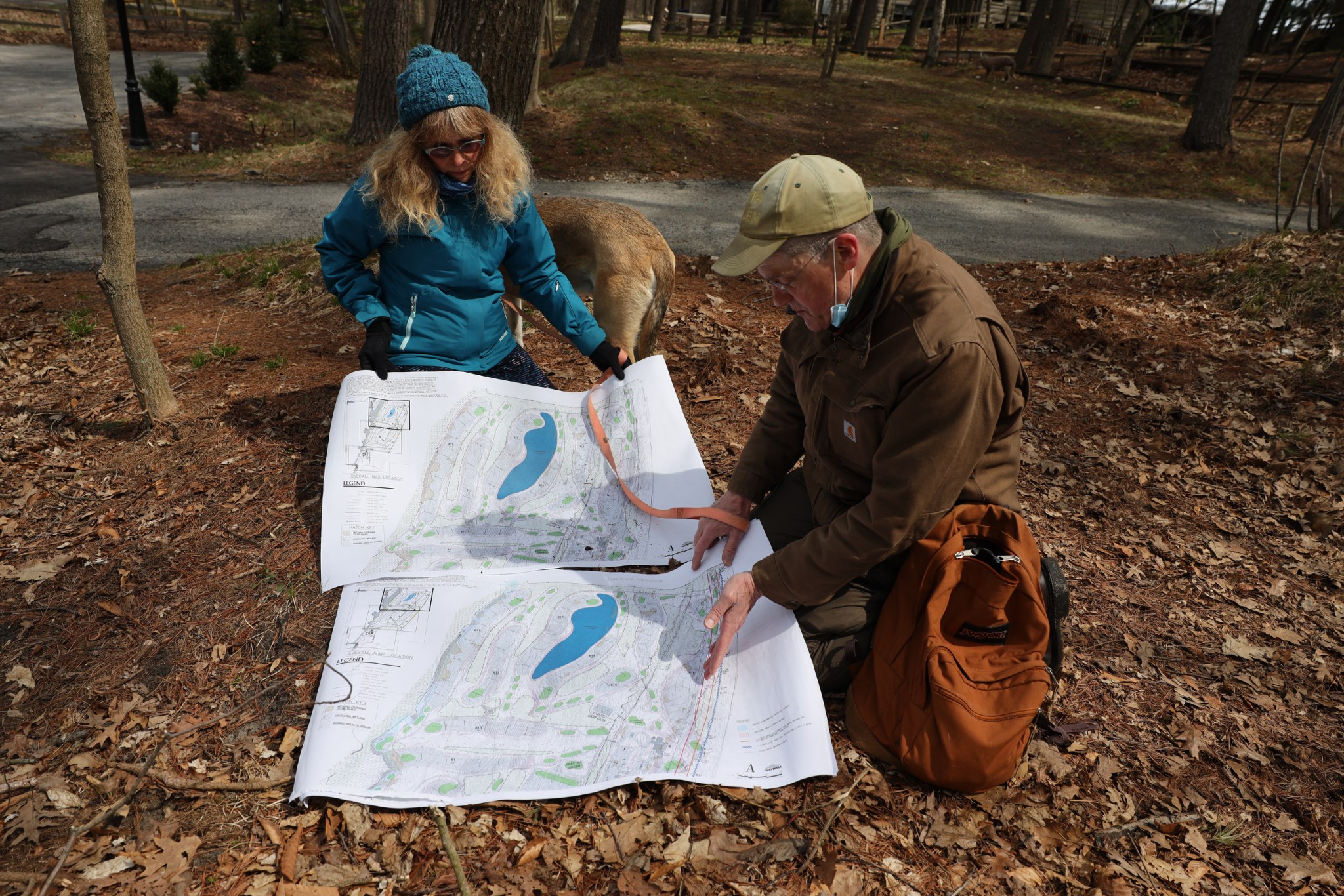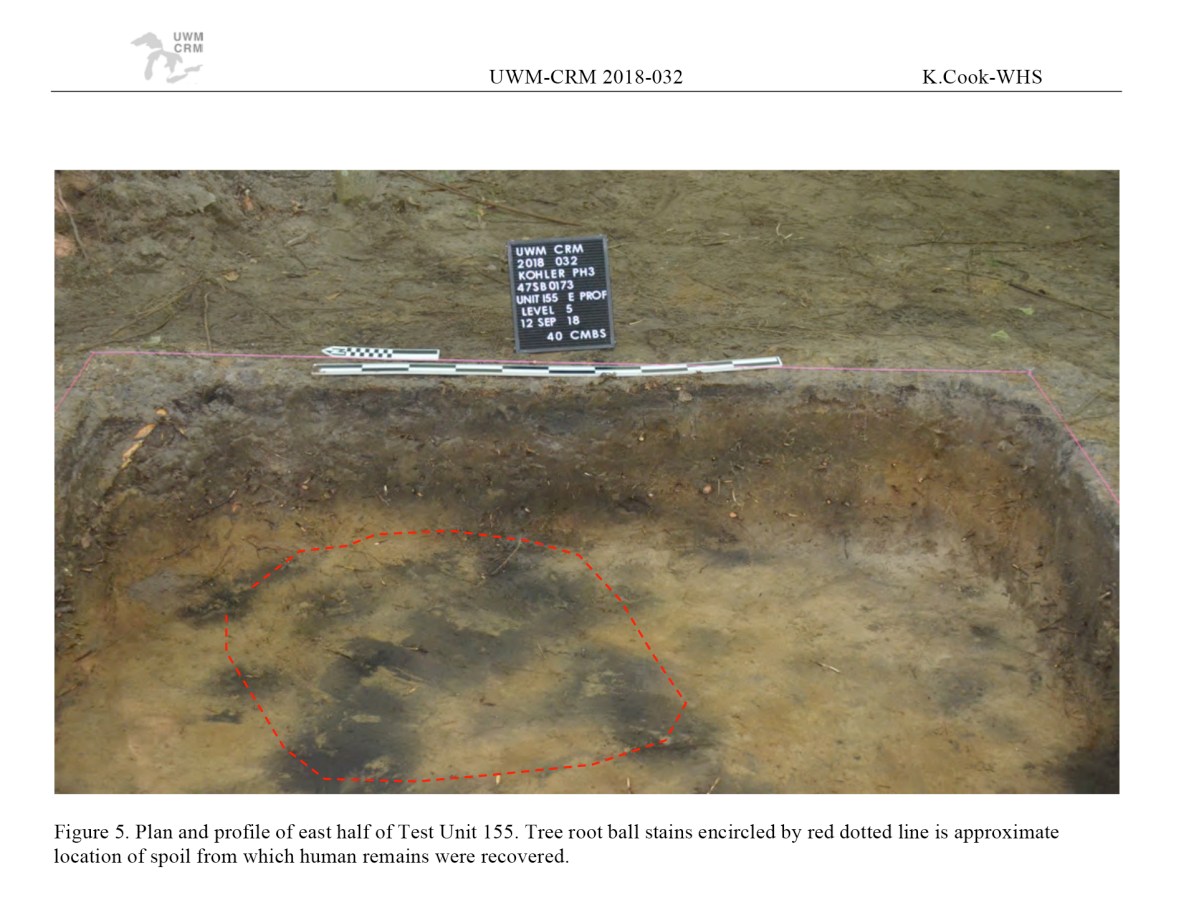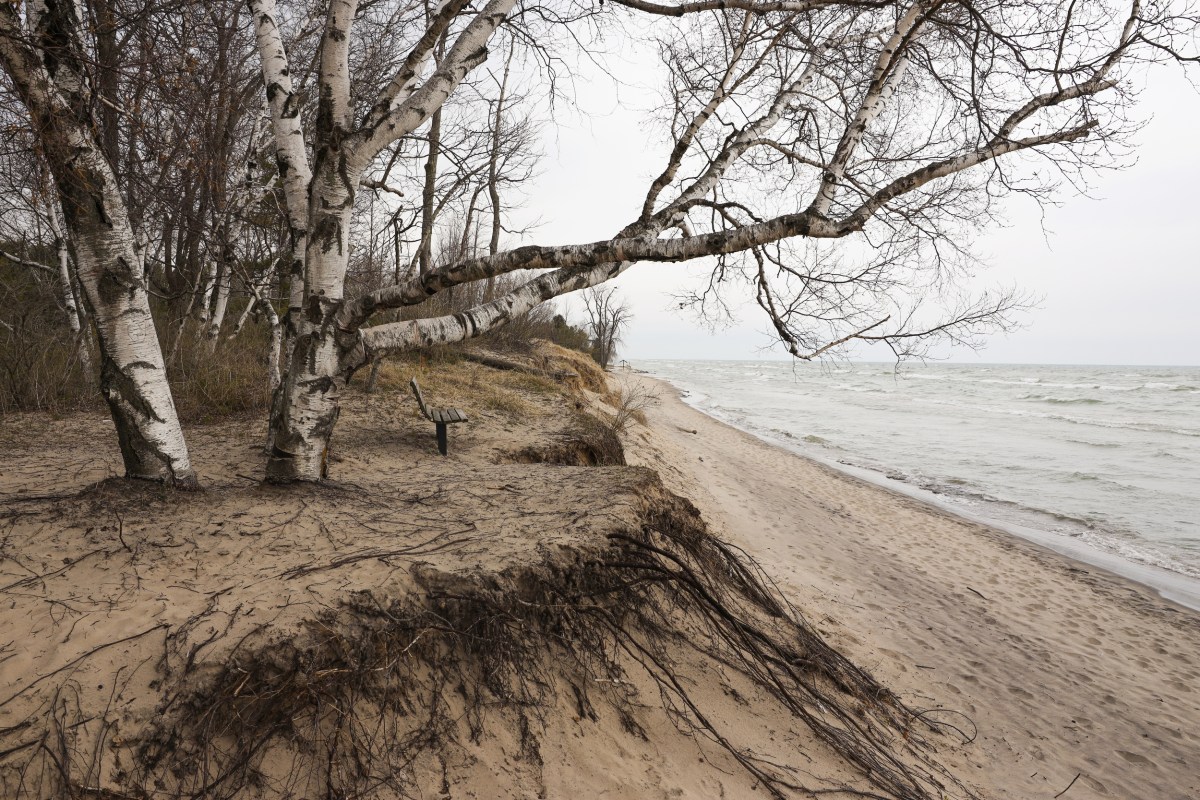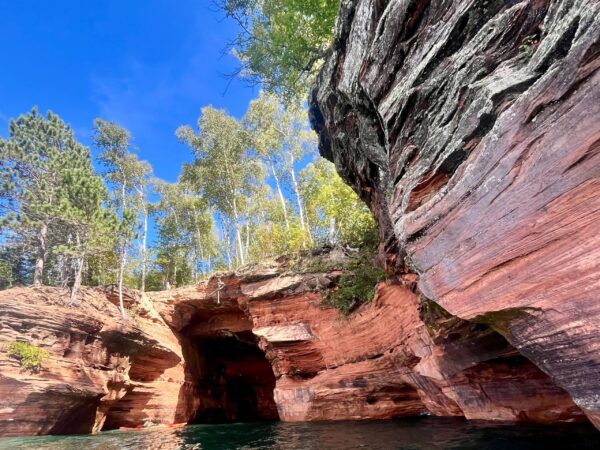
This article, first posted here, was republished with permission from Wisconsin Watch.
By Jim Malewitz, Wisconsin Watch
Archeologists have unearthed human remains of Native Americans who lived up to 2,500 years ago during excavations of the Sheboygan County site along Lake Michigan where Kohler Co. wants to build an 18-hole golf course.
A University of Wisconsin-Milwaukee team in 2018 and 2019 inadvertently encountered fragments of human bone and teeth from at least seven locations beneath the privately-owned wetlands and forest where Kohler Co. envisions its third championship facility in Wisconsin, according to documents obtained by Wisconsin Watch. The disturbance came while recovering tens of thousands of ceramics, tools and other artifacts at the 247-acre site during a study required under federal historic preservation law, according to a 2019 report.
The human remains and most of the artifacts belong to Woodland-era Native Americans who lived between 500 B.C. and 1200 A.D., according to Jennifer Haas, director of UW-Milwaukee Archaeological Research Laboratory Center. The team is still analyzing the burial sites, Haas said in an email, but it did not encounter any definable graves that might trigger additional development restrictions under state burial protection law.
Archaeologists did not examine the multiple Native American burial mounds on the Kohler Co. property that were outside of the proposed golf course, Haas said. The 36,000-employee company — which is known for its bathroom and kitchen fixtures but also manages resorts and golf destinations — vows to leave the mounds undisturbed and offer public access.
“We have worked closely with the Wisconsin Historical Society and concerned Tribal members to ensure that the provision of our state’s burial law is adhered to and the mandated process followed,” Haas told Wisconsin Watch in an email. “As you can imagine, there is tremendous cultural sensitivity surrounding the findings of human remains at the site.”
Ho-Chunk Nation historic preservation officer Bill Quackenbush is among tribal representatives monitoring the archeological project. He notes that state and federal laws do not bar development under such circumstances. Still, it leaves him uneasy.
“Tribes are always reluctant to talk about that one ugly aspect — of having to deal with our ancestors being dug up as somewhat of a commodity,” Quackenbush said.
Dirk Willis, vice president for golf, landscape and retail for Kohler Hospitality, said the company remains “committed to creating a world-class golf course that respects the property’s natural character, and opens up private land to the public for the first time,” while minimizing impact on the landscape and boosting the local economy.
“Our public golf course will be an asset to our region,” he said in a written statement. “The archeology work on the site represents an important historical opportunity for public education about those who came before us and our state’s rich history that could have remained unknown.”

In a 2019 University of Wisconsin-Milwaukee Cultural Resource Management report, a red circle marks the spot where an archeology team inadvertently disturbed Native American human remains in 2018 while excavating land in Sheboygan, Wis., where Kohler Co. wants to build a golf course. The team found fragments of human bone and teeth from at least seven locations at the site. They are thought to belong to Woodland-era Native Americans who lived between 500 B.C. and 1200 A.D. (Photo Credit: University of Wisconsin-Milwaukee Cultural Resource Management)
More complications for golf course
But barriers to completing the project remain: Lake Michigan’s fluctuating water levels and winds have eroded key portions of the site, possibly forcing Kohler to return to Sheboygan County for approval of a modified golf course. And the project remains stalled as lawsuits continue to wind through court.
The grassroots group Friends of the Black River Forest is suing to reverse actions under former Gov. Scott Walker that pushed Kohler Co.’s plans forward. Those include a Wisconsin Department of Natural Resources permit to fill 1.5 acres of rare, Great Lakes Ridge and Swale wetlands and a land swap in which Wisconsin gave up 6.5 acres of Kohler-Andrae State Park for 9.5 acres of Kohler property with a house and several storage buildings.
Meanwhile, the archeological work illustrates the challenges of balancing cultural sensitivities, historic preservation and property rights in Wisconsin, where an estimated 79% of more than 2,600 known Native American burial mounds and 54% of the 9,000-plus known burial sites sit on privately owned land.
Wisconsin is home to the most burial sites in North America, according to the DNR. The state in recent years bolstered protections for these sites, largely as awareness spread of the wide-scale destruction of the estimated 20,000 to 30,000 earthen burial mounds that Native Americans built before Europeans arrived.
But that didn’t prevent a dispute about how archaeologists treated the human remains disturbed at the Kohler site — with concerns from tribal officials reaching top UW System officials, emails show.
Belle Ragins, a UW-Milwaukee professor of management who lives near the Kohler Co. site and opposes the golf course, shared the emails with Wisconsin Watch. She and her husband, Erik Thelen, received them through a February Freedom of Information Act request to the Army Corps of Engineers, which is evaluating Kohler Co.’s application to discharge materials into 3.7 acres of federal wetlands between the Black River and Lake Michigan. But first, the company needs approval of a plan to limit damage to historic cultural resources.
The couple requested the records after noticing archeological digging near the site along Lake Michigan, which she called “ground zero for burial mounds.” Ragins was surprised to learn Kohler was forging ahead with the project even after archeologists identified a group of burial mounds and an initial cache of Woodland-era Native American artifacts several years ago.
“It’s just heartbreaking, because they would never do this if it was their grandmother’s cemetery,” Ragins said, sitting at a picnic table at Kohler-Andrae near the Lake Michigan shore. “They would never say it’s okay to build a golf course on grandma’s grave.”
Ragins, who is white and not of tribal ancestry, said she fears Kohler Co. wants to commoditize the site’s rich Native American culture, citing the company’s, 36-hole Blackwolf Run in the nearby village of Kohler. The course, named after a Ho-Chunk chief, includes one hole named “Burial Mounds,” for its rolling navigational hazards.
Remains ‘must be treated with the utmost dignity’
The Kohler Co. site is eligible for the National Register of Historic Places, and the company funded the archeological work to address the project’s “adverse effect” on the historic location under federal law — a requirement before the Army Corps issues a water discharge permit.
After collecting data, Kohler Co. must eventually present a plan to educate the public about how Native Americans and others long ago lived and worked at the site. Any human remains disturbed during the process “must be treated with the utmost dignity and respect,” according to an agreement between Kohler Co. and state, federal and tribal agencies.
Multiple tribal historic preservation officers objected as the UW-Milwaukee team temporarily stored the human remains rather than allow for an immediate reburial, emails show.
The dispute escalated on July 17, 2019. That’s when a Wisconsin Historical Society official emailed a notice that the UW-Milwaukee team encountered an adult molar tooth — unearthed about 900 yards from bone fragments identified the previous year.
“This is another part of one of our ancestor’s human remains that was found at this site,” replied David Grignon, a historic preservation officer for the Menominee Indian Tribe of Wisconsin. “… Did the project stop or is it going to continue or does the Kohler Company have too much influence to stop it?”
Leslie Eisenberg, a compliance archeologist with the Wisconsin Historical Society’s State Historic Preservation Office, responded that Kohler Co. had clear authority to request to disturb the “uncatalogued” burial site to meet federal historic preservation requirements, and her office granted that permission. Archeologists found the tooth in a sifting screen rather than directly on site, Eisenberg added, making it impossible to leave in place. That was the case with most of the human remains that the team removed from the ground, records show.
“I recently reminded everyone working on this project that if human bone is found during the remainder of the excavation, it should not be moved until every effort is made to avoid, if possible, within the context of the project plans,” she wrote.
The next day, Quackenbush asked to halt the excavation to discuss broader concerns. He called for an immediate reburial of remains where they were found — and for the state to catalog the burial site to bar future development.
“I strongly feel little cultural sensitivity has been given to us tribes … no one seems to take into account these remains are being pulled from the ground against our continued requests not to do so,” Quackenbush wrote in an email. “These remains need to go back into the ground and reburied at the time they are found for them to carry on in their journey.”
Speaking to Wisconsin Watch, Quackenbush described tension from differing cultural perceptions of the remains: Archeologists and agency officials seem to view them as items to be analyzed, while tribal officials see them as ancestors who need a swift return to their final resting place. It’s not unique to the Kohler Co. excavation. Challenges emerge among the hundreds of sites that Quackenbush and colleagues monitor as they undergo similar federal preservation reviews.
“We’re so tired of people analyzing and reanalyzing and trying to make something of use out of our ancestors,” he said. “It’s at a point where we just jump into consultation and try to create an (agreement) to expedite the process” — aiming to limit the time remains are out of the ground.
Ancestors treated as ‘commodity’
The complaint about the Kohler excavation reached university leaders. The UW System and the Board of Regents arranged a conversation between Quakenbush and UW-Milwaukee Chancellor Mark Mone, email correspondence shows.
Days later, John Richards, the since-retired director of UW-Milwaukee’s Cultural Resource Management, promised that university staff would begin placing tobacco with all recovered human remains, wrap them in white cloth and hold them in secure storage pending reburial — while expediting that portion of the analysis.
Ho-Chunk, Menominee and Potawatomi representatives ultimately reburied the remains nearby in summer 2020. The reburial and additional assurances satisfied the participating tribes, Quackenbush said in an interview. But it was a lesson in the limits of how far landowners and archeologists must go under the law in protecting cultural dignity.
“I think protection of human remains and burial on site is a higher priority than the creation of a golf course, for example. But, that said, (the Kohlers) are landowners, and they have the right to do as they see fit,” he said.
Richards declined to comment for this story. Haas, the current project lead, said Wisconsin archeologists commonly disturb human remains during their work, and her staff took pains to handle them carefully during the Kohler Co. excavation.
“Inadvertent discovery protocols were reviewed and put in place — these protocols, in concert with the protections afforded by our state’s burial law, and our professional decorum, helped to ensure ethical and culturally sensitive treatment of human remains,” she told Wisconsin Watch in an email.

Lake Michigan shoreline is seen at Kohler-Andrae State Park near Sheboygan, Wis. The area supports rare and fragile interdunal and ridge and swale wetlands systems, Pat Trochlell, a retired Wisconsin Department of Natural Resources wetland ecologist, told Wisconsin Watch in 2018. The habitat was created over thousands of years, continually shifting with the wind. The dunes are held together without soil by roots, supporting several threatened species of plants and insects. Photo taken April 27, 2021. (Photo Credit: Dee J. Hall/Wisconsin Watch)
Project faces delays
Haas’ team is still inventorying and analyzing roughly 38,000 historic and 214,000 prehistoric artifacts. It won’t file a draft report until spring 2023, Haas said, which the Wisconsin Historical Society must approve. Only then can the Army Corps issue its water discharge permit — potentially delaying development for years.
That’s just one hurdle Kohler Co. must clear to build the scenic golf course it envisions.
In the 1930s, the company, headquartered in the Sheboygan County village of Kohler, purchased 468 acres of land along Lake Michigan and donated nearly half to what is now the Kohler-Andrae State Park. The rest is now slated for the golf course.
Though Kohler Co. has yet to break ground, it already flexed its political muscle to change its political boundaries: It worked with Sheboygan officials to annex the land into the city after key officials and residents of the town of Wilson, where the proposed golf course would be built, openly opposed the project. The annexation sparked a legal battle, which the Wisconsin Supreme Court in 2020 resolved in Kohler Co.’s favor. Months later, the Sheboygan Plan Commission granted the company a conditional use permit.
To build the course, Kohler Co. says it must destroy nearly 4 acres of wetlands. The company plans to cut down half of the trees on the property, create an irrigation pond, golf cart paths, a clubhouse of up to 16,000 square feet, a 22,000-square-foot maintenance building and an entry road.
Kohler Co. vows to remediate destroyed wetlands through programs that allow it to sponsor the restoration or creation of wetlands elsewhere. Said Willis:
“Our company has an established track record of good business and environmental stewardship.”
But some scientists say the development will permanently alter ecosystems across the rare landscape, paving the way for invasive species and removing trees that migrating birds depend upon. And one former DNR wetland ecologist told Wisconsin Watch in 2018 that Kohler Co. failed to meet state standards for a wetlands permit — but DNR managers pressured employees to approve the permit anyway.
An administrative law judge revoked the permit in 2019, siding with Friends of the Black River Forest; Kohler Co. appealed, and the case remains in Sheboygan County Circuit Court.
Separately, the Wisconsin Court of Appeals last September reinstated the group’s challenge of the state land swap after a lower court initially tossed it for lack of standing.
Kohler Co. faces yet another challenge: the eroding Lake Michigan shore, which could leave some holes under water unless designs change — particularly the planned 18th hole, where photos taken by Thelen show rapid land loss over the past year.
“I mean, the beaches are gone,” Ragins said. “The 18th hole is in the middle of Lake Michigan.”
Any redesign could require the company to return to Sheboygan’s Plan Commission.
“Should the course design be changed, depending on the nature of the change, it would likely require an amendment to the approval,” Chad Pelishek, the city’s planning and development director, said in an email. “However, the exact process will be dependent on the specific changes needed.”
Asked whether a redesign was necessary, Willis said the course’s initial routing and design “remains unchanged.”
And if Kohler Co. takes steps to protect its shoreline by building sloping barriers called revetments? That could speed up erosion along Kohler-Andrae State Park shoreline downstream, worries John Ehmann, who chairs the Wilson Town Board, which lost authority over the site when Sheboygan annexed it.
“I walk their property several times a week on the shoreline there, and the erosion’s been tremendous,” he said. “I don’t see how they could build a golf course there without fortifying that.”
Wisconsin Watch Managing Editor Dee J. Hall contributed to this report. The nonprofit Wisconsin Watch (www.WisconsinWatch.org) collaborates with WPR, PBS Wisconsin, other news media and the UW-Madison School of Journalism and Mass Communication. All works created, published, posted or disseminated by Wisconsin Watch do not necessarily reflect the views or opinions of UW-Madison or any of its affiliates.
Catch more news on Great Lakes Now:
Dune Dispute: Wisconsin Lake Michigan shoreline threatened by adjacent golf course development
Wetlands can help prevent property damage and save lives during floods
H2Ohio: Agency directors focus on wetlands, farmer subsidies, replacing lead lines
API key not valid. Please pass a valid API key.Featured image: Belle Ragins and Erik Thelen, who live near the site of Kohler Co.’s proposed golf course in Sheboygan, Wis., examine a map prepared by environmental engineer Roger Miller, who chairs the town of Wilson Plan Commission. The map overlays the project with present lake levels, showing several planned features under water due to erosion and fluctuating water levels along Lake Michigan’s shoreline. Photo taken April 27, 2021. (Photo Credit: Dee J. Hall/Wisconsin Watch)
1 Comment
-
With this ongoing site could it be possible for any enrolled tribal members to view the site?




